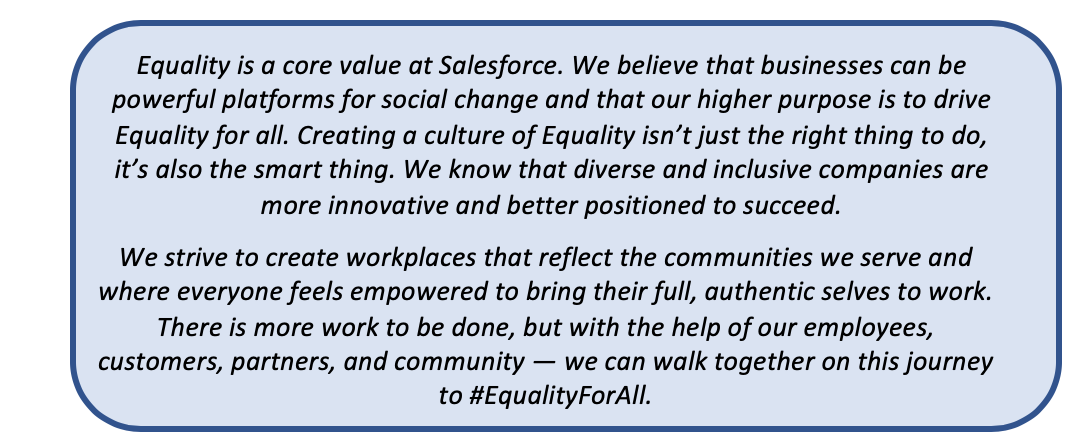MARY MASON’S DEI SPOTLIGHT: DEI PRACTICES AT SALESFORCE
Mary Mason Boaz | September 5, 2019
This month we’re going to explore the importance of a clarified purpose and focus when seeking to move the needle around issues of diversity, equity, and inclusion. We’ll be drawing on a best practice from Salesforce, a leading CRM platform, that employs 25,000+ people across the world and was voted the World’s #1 Best Place to Work and one of the top 20 Best Workplaces for Diversity in 2018 by Fortune.
The Salesforce Challenge: Pay gaps and workplace equality
In 2015, Chief Personnel Officer Cindy Robbins first raised the issue of a pay gap between men and women at Salesforce by bringing it to the attention of CEO Marc Benioff. Upon further analysis, Salesforce also identified compensation discrepancies by race and ethnicity and a gender opportunity gap at the highest levels of leadership. Salesforce identified a need to remedy the pay inequities, but also to focus on workplace equality more broadly.
The Salesforce Solution: Clarified Focus on What Matters
The company curated a special report The Impact of Equality and Values Driven Business which examined their diagnosis and solution, noting , “A new business model for companies is emerging — one that calls for companies to expand their purview beyond profit, adopt a holistic approach to societal impact, and actively work toward achieving workplace equality.”
To create true change, Salesforce recognized that a financial commitment without vision and accountability wouldn’t move the needle. Instead, they have explicitly defined what they mean when they discuss “workplace equality” in their statement on their website:

Salesforce has also outlined and defined their Four Core Pillars of Equality:
- Equal Rights: We advocate for Equality in the communities
 where we live and work, including standing against anti-LGBTQ legislation and standing for marriage Equality.
where we live and work, including standing against anti-LGBTQ legislation and standing for marriage Equality. - Equal Pay: In 2015, we made a commitment to ensure equal pay for equal work. Since then, we’ve conducted four global equal pay assessments and invested $10.3 million to address unexplained pay differences between genders, and across race and ethnicity in the U.S.
- Equal Education: We believe Equality begins with education. That’s why we’ve donated more than $50 million to US public schools and employees volunteer at 106 schools globally as part of the Circle the Schools program.
- Equal Opportunity: We strive to create workplaces that are reflective of the communities we serve. We do this through our Equality Groups, our allyship practices, workforce development programs, inclusive practices, employee training and more.
They publish their diversity numbers each year to highlight their successes, failures, and their path forward. Here is an example from their 2018 report:

The Bottom Line: Organizations that clarify their purpose and focus are better positioned to move the needle around issues of diversity, equity, and inclusion
The Salesforce team had leaders at senior levels that were willing and able to identify and name gaps around diversity, equity, and inclusion. They pushed to analyze their data by key demographics to further understand additional inequities and created a plan, in partnership with the broader staff and community, to take a stand regarding what matters to them.
The Talent Lesson
In order to maintain the highest possible bar for students, schools must create programs that are diverse, equitable, and inclusive for their staff and students. Once an organization has a clarified focus on their DEI priorities and has defined what those mean, they can then assign ownership, create metrics, and identify tactics to reach their goals. Without those things in place, many organizations stall to make any progress around diversity, equity, or inclusion.
To determine your own DEI priorities and clarify your focus, consider:
- Assigning an internal senior leader to be accountable for moving the work forward
- Reviewing quantitative and qualitative staffing data (compensation, promotion, evaluations, recruitment, hiring, staff perception interviews, etc.) with a DEI lens to identify gaps or trends
- Creating an inclusive committee of stakeholders to support the creation and definition of the organization’s DEI priorities
JOIN THE CONVERSATION
These are my thoughts on how the Salesforce focus might be helpful in a school context. What do you think? What about this model doesn’t work for schools? Join the conversation with Mary Mason and the EdFuel team on email, Twitter or Instagram
